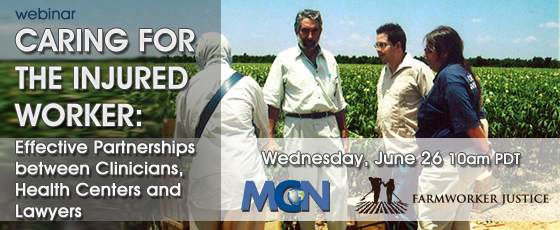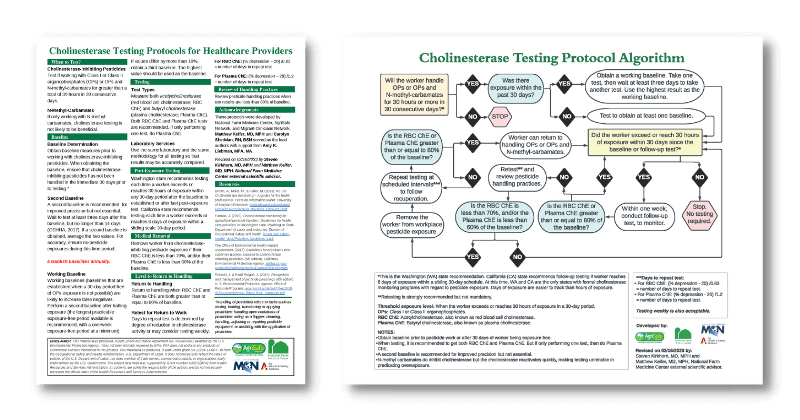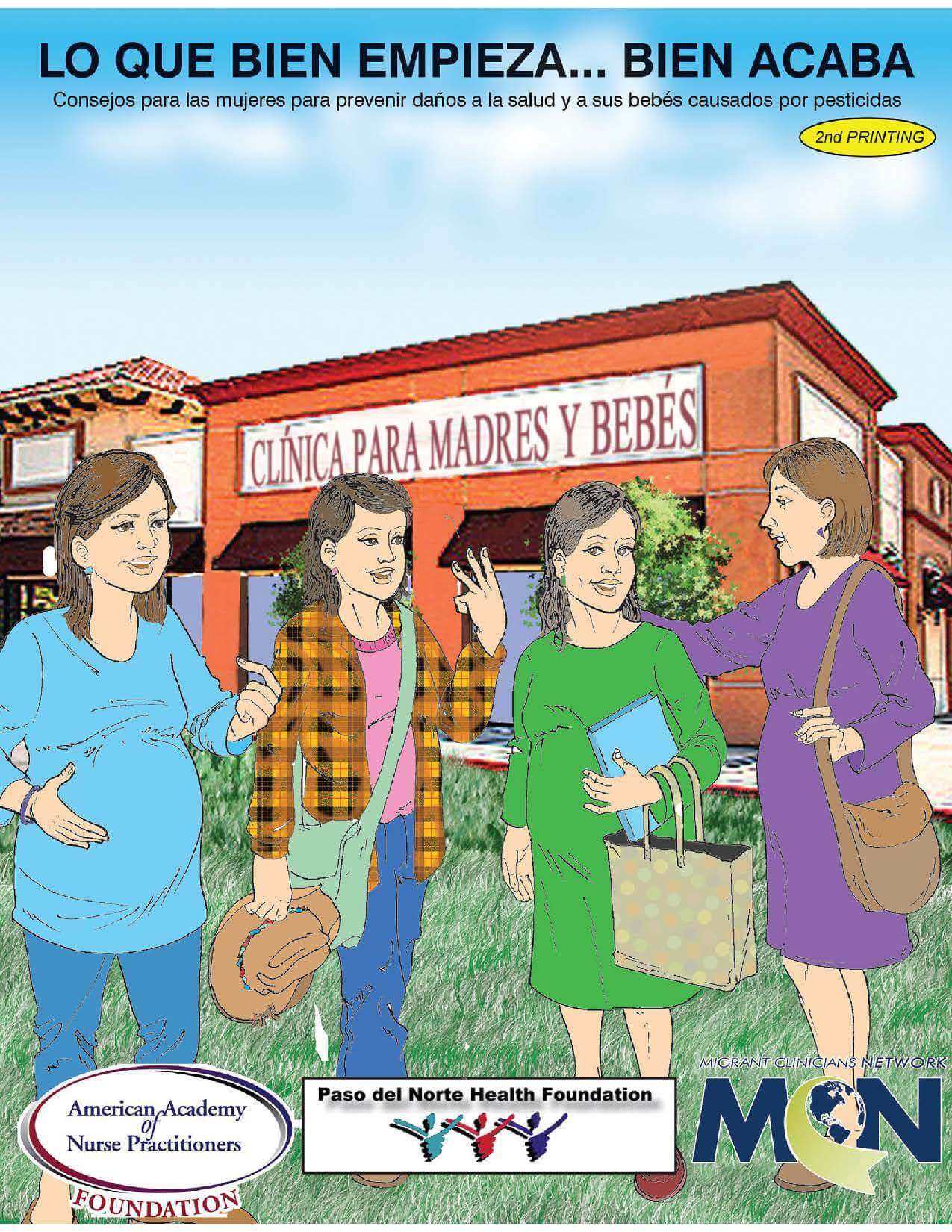These bilingual posters educate workers on how to work safely with machinery on the farm. Developed by two Occupational Health Interns (OHIP) during their internship with the National Farm Medicine Center, these posters accompany the Seguridad en las Lecherías curriculum.
- TractorPosterENG2016.pdf (5.97 MB)
- TractorPosterSPAN2016.pdf (6.03 MB)
On Monday August 18, 2014 MCN submitted technical comments to the EPA regarding the proposed changes to the Worker Protection Standard. View MCN's recommendations for advancing stronger safeguards to protect farmworkers from pesticide exposure.
- MCN_WPS_FinalComments_2014.pdf (164.74 KB)
http://umash.umn.edu/needlestick-prevention/ This webpage features factsheets and videos developed by the Upper Midwest Agricultural Safety and Health Center (UMASH) to educate farmworkers, producers, and veterinarians about needlestick prevention. Resources are available in both English and Spanish.
Este diccionario ilustrado bilingüe de MCN, "Seguridad en Palabras/ Safety in Words", muestra los peligros que hay en el lugar de trabajo y las mejores prácticas para la salud y la seguridad en la agricultura. Desarrollado con el apoyo del Programa de Subvenciones Susan Harwood de OSHA, este recurso refuerza el vocabulario en inglés de los trabajadores que hablan español lo que ayudará a prevenir lesiones en la agricultura.
Three concise and effective environmental/occupational health screening questions for the primary care provider. English and Spanish. MCN, 2014.
An EHR-friendly version of these screening questions was developed through MCN's Workers & Health Program. This can be used as a reference for integration into the health center's Electronic Health Record.
- EOHScreeningQs_2014Nov.pdf (3.99 MB)
- EOHScreeningQs_EHR_2014Nov.pdf (4.49 MB)
Print, cut, and distribute this handy bookmark to providers who treat migrant and seasonal farmworker patients. The bookmark includes links and a qr code to connect you to pesticide - related clinical tools and resources. In addition, we've included some useful phone numbers in case of a pesticide emergency.
You can also use the bookmark to keep handy the Health Network phone number to be sure your patients on the move remain in care.
- EOHbookmark_final_92013.pdf (722.68 KB)
This colorful bilingual comic addresses workers' compensation and immigrant dairy farm workers’ rights and responsibilities. It tells the story of a Mexican dairy farm worker who is injured on the job and the steps he and his employer take to make sure he receives his benefits, and the farm improves its safety.
- DairyWrkrRightsWrkComp_ENG2016_web.pdf (7.78 MB)
- DairyWrkrRightsWrkComp_ESP2016_web.pdf (7.92 MB)
- COMIC - Safety and Health on the Farm - New Mexico - English.pdf (3.4 MB)
- COMIC - Safety and Health on the Farm - New Mexico - Spanish.pdf (3.41 MB)
- COMIC - Safety and Health on the Farm - New York - English.pdf (3.45 MB)
- COMIC - Safety and Health on the Farm - New York - Spanish.pdf (3.46 MB)
- COMIC - Safety and Health on the Farm -Minnesota -English.pdf (7.78 MB)
- COMIC - Safety and Health on the Farm - Minnesota - Spanish_0.pdf (7.91 MB)
MCN's Director of Environmental and Occupational Health, Amy K. Liebman, appeared on the radio broadcast Epicenter: West Marin Issues on KWMR 90.5 FM to talk pesticides and the Worker Protection Standard. Liebman was joined by Hector Sanchez of the Labor Council for Latin American Advancement. Host Frederick Smith discusses with Liebman and Sanchez a variety of pesticide-related issues, including protections for farmworkers and their families, farmworkers' risks of pesticide exposures, how pesticides are regulated, their health effects on farmworkers and their families, and what healthcare providers can do to mitigate, diagnose, manage, and report pesticide exposures.
During the interview Liebman referenced the Agricultural Health Study, which is available here.
- http://kwmr.org/show/186
- http://kwmr.org/show/186','','location=yes,scrollbars=yes,menubar=yes,resizable=yes,width=960,height=720,left='+(screen.availWidth/2-480)+',top='+(screen.availHeight/2-360)+
- http://www.lclaa.org/
- http://aghealth.nih.gov/
- http://aghealth.nih.gov/','','location=yes,scrollbars=yes,resizable=yes,width=960,height=720,left='+(screen.availWidth/2-480)+',top='+(screen.availHeight/2-360)+
- https://w.soundcloud.com/player/?url=http%3A//api.soundcloud.com/tracks/108699853
A report prepared by researchers at The George Washington University School of Public Health and Health Services features a wealth of information on occupational health and safety and the migrant population, from farmworkers to fast-food chain employees to restaurant cooks and servers.
News release:
http://defendingscience.org/news/labor-day-looking-back-year-us-occupational-health-and-safety
- H&S Report2013 reduced size.pdf (3.21 MB)
Introduction
In August of 2005, the North Carolina Division of Public Health, Occupational and Environmental Epidemiology Branch (OEEB) was notified that three women who had worked on farms in North Carolina owned by Ag-Mart had delivered infants with birth defects. All three births took place in Florida where the women also worked on Ag-Mart farms and lived near each other. This report summarizes the OEEB’s investigation and assessment of the pesticide exposures likely experienced by these women while in North Carolina.
- Agmartreleasereport.doc (198.5 KB)
The Occupational Health and Safety Resource Center is a virtual repository of Spanish educational materials, data sources, and links to bilingual informational websites on occupational health and safety issues related to agricultural work. It also contains an ample list of national and state agencies that have produced materials in Spanish for farmworkers’ health-related problems.
MCNs own Deliana Garcia helped in being a part of the advisory committee to this resource center.
What is the objective? To facilitate a central access point to high quality Spanish educational materials on agricultural occupational health and safety issues for people conducting work on health promotion and prevention activities and on workers’ rights and problems related to agricultural work.
Who are the target audiences? Health-outreach workers (promotores), community advocates, health providers, contractors/employers, farmworkers and their families, and others interested in the health and safety issues of agricultural workers.
What areas are included? The materials cover five key relevant areas: 1) Farmworkers’ rights; 2) Injury prevention; 3) Respiratory illnesses; 4) Heat illnesses; and 5) Pesticide exposure.
How did we do it? To develop the Virtual Resource Center, the process entailed:
- Asset mapping of educational, informational and research materials available in Spanish related to the five mentioned areas.
- Selection of materials using the following criteria: accurate information, culturally and linguistically adequate (including literacy level), relevant to health area, and visually acceptable quality.
- Insertion of resources into an excel format under five different categories, including source, type of material, and description of its content.
Development of new materials: to complement the existing educational resources, we developed a “Promotores Training Manual on Occupational Health and Safety of Agricultural Workers”. Based on an ethnographic framework, the manual presents the perspective of agricultural workers on the five mentioned areas (their stories) and provides community health workers with tools on how to conduct prevention and promotion activities. It also refers them to existing resources. We also produced a series of Spanish and selected indigenous languages Public Service Announcements (PSAs) on these areas.
An informative blog about workers' compensation, risk management, business insurance, workplace health & safety, occupational medicine, injured workers, and related topics.
Glenn Shor, Phd, MPP, Visiting Policy Analyst at the Center for Occupational and Environmental Health at the UC Berkeley School of Public Health.
This report was funded, in part, by The California Wellness Foundation, for UCSF Community Occupational Health Project, Barbara Burgel, Nan Lashuay, and Robert Harrison, 2004 - 2006.
- Low wage clinical care_Shor.pdf (177.29 KB)
A tool for health care providers and others to assist agricultural workers in accessing workers' compensation benefits. A Farmworker Justice/MCN resource.
- GUIDE_WorkmansComp_2015_0.pdf (1.67 MB)
These are the slides from an MCN/ Farmworker Justice sponsored webinar titled "Caring for the Injured Worker: Effective Partnerships between Clinicians, Health Centers, and Lawyers."
Originally presented on Wednesday June 26, 2013
PRESENTERS: Brent Probinsky, JD, Probinsky and Associates, PA
Dr. Ed Zuroweste, MD, Chief Medical Officer, Migrant Clinicians Network

- CaringforInjuredWorkersWebinar2013_0.pdf (3.01 MB)
This webinar is the third in a series of seven in our Clinician Orienatation to Migration Health.
DATE RECORDED: Wednesday, April 17, 2013
PRESENTED BY: Edward Zuroweste, MD, Chief Medical Officer, Migrant Clinicians Network
To view the recorded version of this webinar, click here.
- ChronicInfDisWebApr2013_MCN.pdf (3.97 MB)
This webinar is the second in a series of seven in our Clinician Orientation to Migration Health.
DATE RECORDED: Wednesday, March 13, 2013
PRESENTED BY: Jennie McLaurin, MD, MPH, Specialist in Child and Migrant Health, Migrant Clinicians Network
To view the recorded version of this webinar, click here.
- cxprofMCN2013.pdf (2.18 MB)
Farmworker Justice and MCN compiled state-by-state requirements for employers to provide workers compensation to agricultural workers. The document sites case law where applicable.
At Workers' Comp Hub we provide basic information for workers with job-related injuries and illnesses. We also share resources to advance pro-worker advocacy and action.
The Federal Insecticide, Fungicide, and Rodenticide Act (FIFRA) provides for federal regulation of pesticide distribution, sale, and use. All pesticides distributed or sold in the United States must be registered (licensed) by EPA. Before EPA may register a pesticide under FIFRA, the applicant must show, among other things, that using the pesticide according to specifications "will not generally cause unreasonable adverse effects on the environment.''
October 15, 2012
Background
The Centers for Disease Control and Prevention (CDC) with state and local health departments and the Food and Drug Administration (FDA)![]() are investigating a multistate meningitis outbreak of fungal infections among patients who have received a steroid injection of a potentially contaminated product into the spinal area. This form of meningitis is not contagious. The investigation also includes fungal infections associated with injections in a peripheral joint space, such as a knee, shoulder or ankle.
are investigating a multistate meningitis outbreak of fungal infections among patients who have received a steroid injection of a potentially contaminated product into the spinal area. This form of meningitis is not contagious. The investigation also includes fungal infections associated with injections in a peripheral joint space, such as a knee, shoulder or ankle.
http://www.farmworkercliniciansmanual.com
This comprehensive manual was developed by the New York Center for Agricultural Medicine and Health and the Migrant Clinicians Network for the diagnosis and treatment of occupational injuries in migrant and seasonal farmworkers. The information in the manual does focus on agricultural occupations in the Northeast.
¡Cuídate! is an educational resource on the prevention of musculoskeletal injuries at work. This comic is in Spanish, English and Haitian Creole.
- injury prevention ENGLISH 2019.pdf (19.34 MB)
- injury prevention SPANISH 2019.pdf (11.9 MB)
- injury prevention WEB CREOLE AUG 14 2019.pdf (12.77 MB)

These Cholinesterase (ChE) clinical tools provide a concise and simple format to guide clinicians in monitoring the ChE levels for patients working with Class I and Class II organophosphates (OP) or OP and N-methyl-carbamates.

MCN Spanish educational comic book that addresses pesticide exposure in women of reproductive age. LO QUE BIEN EMPIEZA...BIEN ACABA: Consejos para las mujeres para prevenir daños a la salud y a sus bebés causados por pesticidas.
- lo que bien empiezacomic 2015-20mb.pdf (16.45 MB)
The 2012 Blueprint for Protecting Children in Agriculture. Awarded 2013 Paper of the year by the International Society for Agricultural Safety and Health (ISASH), this National Action Plan takes an updated look at preventing childhood agricultural injury and death.
- BlueprintAgricultureNCC_0.pdf (6.84 MB)
This booklet is intended to help Community Health Centers put in place an effective and efficient workers' compensation program.
- MedicalServicestoWorkers-2012.03.27.pdf (5.57 MB)
MCN's Pesticide Clinical Guidelines and Pesticide Exposure Assessment Form assist in the recognition and management of acute pesticide exposures in primary care settings.
The pesticide guidelines were adapted from guidelines developed by Dr. Dennis H. Penzell, a former medical director of a Community and Migrant Health Center with experience in large-scale pesticide exposure incidents.
The Acute Pesticide Exposure Form was adapted from the data collection on an acute pesticide exposed patient tool developed by Matthew C. Keifer, MD, MPH, Director of the National Farm Medicine Center, appearing in the EPA's Recognition and Management of Pesticide Exposures, 6th Edition, EPA 2013.
These resources were developed with guidance from MCN's Environmental and Occupational Health Advisory Committee - a panel of healthcare professionals and researchers with expertise in pesticides and migrant health.
- PesticideClinicalGuidelines_2014Nov.pdf (395.73 KB)
- 2022-Pesticide-Exp-Assessment_ENG.pdf (316.56 KB)
- 2016-08-16 - Acute Pesticide Exposures Clinical Guidelines (Spanish).pdf (203.88 KB)
- 2022_Pesticide-Exp-Assessment_SPA.pdf (626.33 KB)